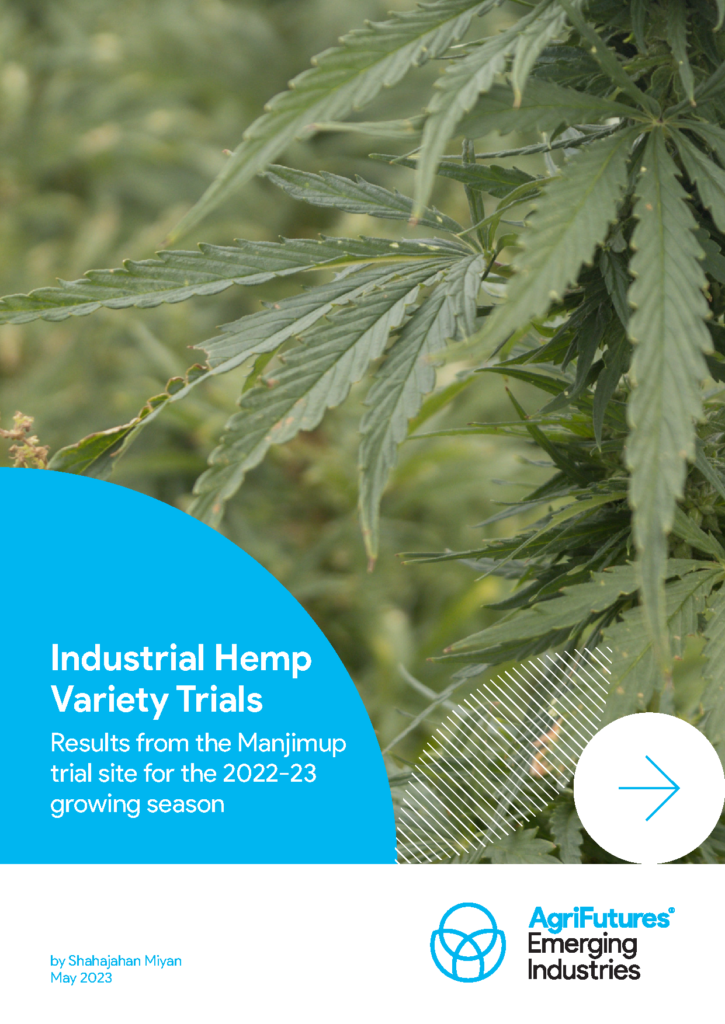AgriFutures Australia has identified that the industrial hemp (Cannabis sativa L.) industry is poised for significant growth, attributed in part to the plant’s extensive range...
 INDUSTRIAL HEMP
INDUSTRIAL HEMP
Industrial Hemp Variety Trials: Results from the Manjimup trial site for the 2022-23 growing season

34 pages
Published: 6 Dec 2023
Author(s): Shahajahan Miyan
ISBN: 978-1-76053-446-2
-
Download report PDF
Download -
Purchase a hard copy - AUD $50
AgriFutures Australia has identified that the industrial hemp (Cannabis sativa L.) industry is poised for significant growth, attributed in part to the plant’s extensive range of sustainable applications. Against this backdrop, the AgriFutures Emerging Industries Program has invested in a series of variety trials to understand the crop’s performance across Australia.
The three-year Industrial Hemp Variety Trials program is into its second year and is providing valuable information to Australian hemp growers by assessing different hemp seed and dual-purpose varieties suitable for different regions across the country. Trial sites have been established in nine locations, including in the Northern Territory, South Australia (2), Tasmania, Victoria, Western Australia (2), New South Wales and Queensland. During the 2022-23 growing season, a field trial was conducted at the Department of Primary Industries and Regional Development’s (DPIRD) Manjimup Horticultural Research Institute under irrigated conditions. Seed varieties were sourced from Australia, Canada, France and Poland.
Two time of sowing (TOS) trials were conducted: the first from 1 November 2022, with eight varieties sown; and the second from 24 November 2022, with 11 varieties sown. All observed parameters showed differences between the varieties. Plant counts ranged from 67 plants/m² for the variety Rajan to 135 plants/m² for Bialobrzeskie. Plant height varied from 79 cm for X-59 to 185 cm for Ruby. Total dry matter yield ranged from 3,720 kg/ha for Fedora-17 to 11,304 kg/ha for Ruby. Grain yield varied from 636 kg/ha for Rajan to 1,103 kg/ha for Bialobrzeskie. Thousand-grain weight ranged from 10.28 g for Henola to 14.46 g for Ruby. Grain bulk density varied from 38.0 kg/hL for Fibror-79 to 55.2 kg/hL for X-59. Protein content ranged from 23.95% for Ruby to 26.85% for Bialobrzeskie. Oil content varied from 21.02% for Henola-09 to 29.53% for Bialobrzeskie.
The analysis conducted for both times of sowing reveals a interactions between variety and sowing time in total dry matter production. This interaction is particularly noticeable with Ruby, which produced significantly higher dry matter at harvest for TOS 1 plots (11,350 kg/ha) compared to TOS 2 plots (7,764 kg/ha). All other varieties produced similar dry matter from early or late sowing.
Bialobrzeskie had the most plants establish with 135 plants/m² (91% of target plant density), while Rajan had the least, 67 plants/m² (45% of target plant density). Other varieties were not statistically different. Grain yield was significantly different for varieties but not for sowing times. Bialobrzeskie produced the highest grain yield (1,103 kg/ha) and Rajan recorded the lowest grain yield (636 kg/ha).
The four varieties common to the 2021-22 and 2022-23 growing seasons – CFX-2, CRS-1, Henola and Katani – were compared. Grain yield showed no significant difference between the varieties within a year, but there was a general trend of decreased grain yield in 2022 compared to 2021. Analysis of oil content revealed a significant effect of variety. Grain oil content varied from 23.8% (Henola) to 28.7% (CFX-2) in 2021, and 21.7% (Henola) to 28.7% (CFX-2) in 2022.
The trial results show that Bialobrzeskie, Henola, Ruby and X-59 have the potential to perform better in terms of grain yield, oil content and protein content compared to other varieties trialled in this region.




